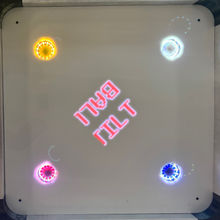May - Finalizing the Tilt Ball Machine
Preparing the Tilt Ball Machine for the showcase was my main goal for this month.

The DPEA hosted a showcase at the end of May for the seniors to show off their projects. Preparing the Tilt Ball Machine for the showcase was my main goal for this month. I got the LEDs, air pistons, and sensors to work in harmony, creating a cohesive game to show to young children, high school students, parents, and industry partners (figure 1). There are two modes, active and idle, that have unique combinations of light shows and air piston functionality. Because the button was never installed, the modes are toggled when all four balls are detected in the goals. The biggest challenge I ran into when programming was changing the way I programmed the LED rings. Instead of each ring being wired separately, all four of them were wired in sequence, meaning the program viewed them as existing in one long strip instead of as separate. I was able to work around this by adding additional parameters to specify which section of the LED strip I wanted to modify (figure 2).
The showcase provided an opportunity for me to collaborate with the Tilt Ball Machine’s product development team and the person behind the electrical systems. We were able to modify our explanation of the project based on the audience’s knowledge and experience, which led to a variety of different people being able to enjoy the game. The children were my favorite audience because I am passionate about inspiring young people to become interested in STEM. They also appeared to be the most excited about the project, which reassured my group and I that the Tilt Ball Machine suits the needs of its target audience.
DELTAs:
Programming literacy: While translating my existing LED code to work on the Tilt Ball Machine, I noticed that having a variable to save the default color values for each LED ring would make the process simpler. After making a two-dimensional array to contain both the LED Ring object and its corresponding RGB values, I decided to update the LED functions to take a list with the RGB values instead of 3 separate integers. However, there was a slight error that I overcame by changing it from a list to a tuple and specifying that it needs to contain 3 integer values (figure 3).
Collaboration: The retro screen was experiencing technical issues that required me to collaborate with Sierrah and Mr. PZ. The text was not showing through the white acrylic, but Ms. Rogers wanted me to test if the screen text could be brighter before installing a clear panel. I tried to run code that I knew worked on the screen previously, but only faint red dots would show up. Mr. PZ and Sierrah worked with me to see if there were any electrical issues, and it was discovered that there was a missing power supply. Now, the screen text shines through the white acrylic on both screens and does not require a clear panel.


